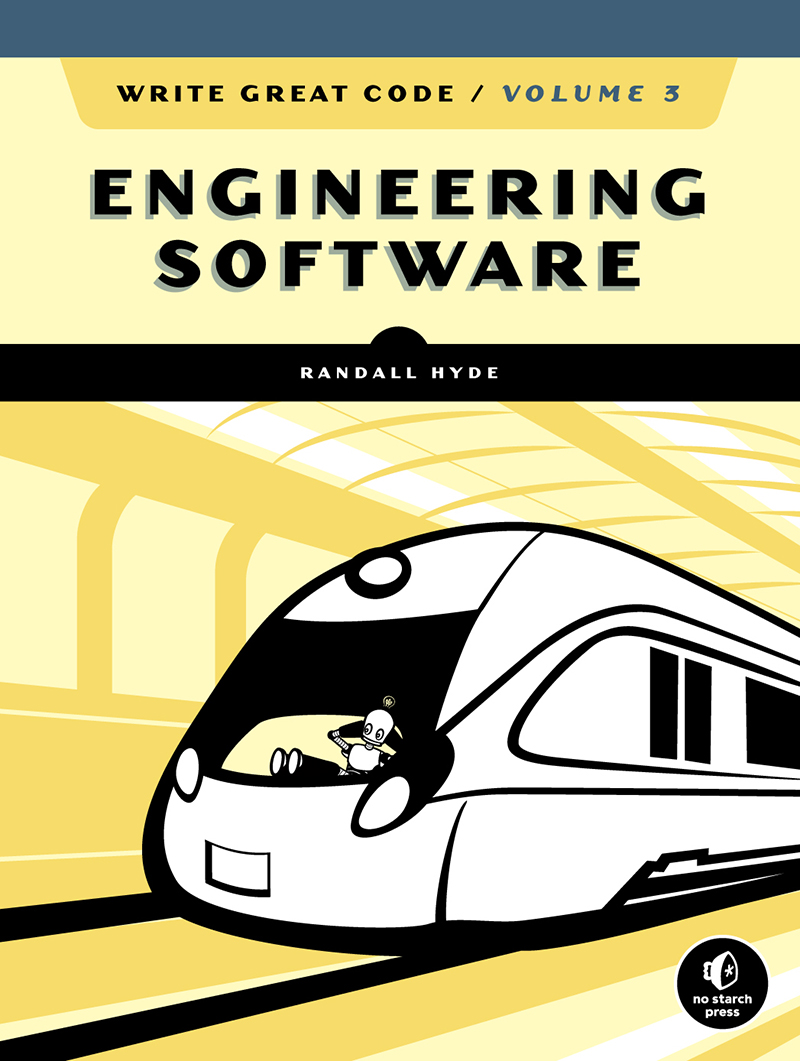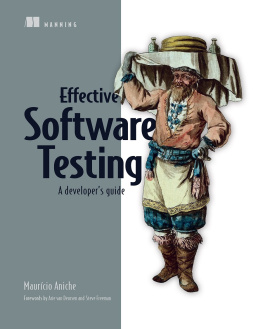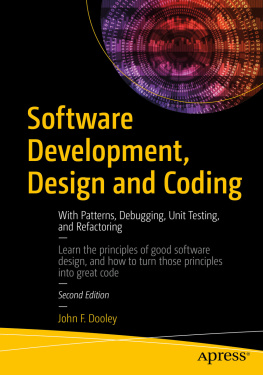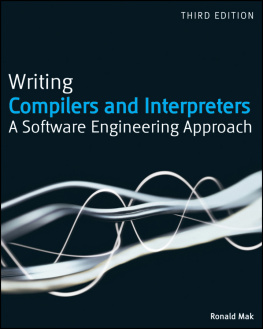Randall Hyde - Write Great Code, Volume 3: Engineering Software
Here you can read online Randall Hyde - Write Great Code, Volume 3: Engineering Software full text of the book (entire story) in english for free. Download pdf and epub, get meaning, cover and reviews about this ebook. year: 2020, publisher: No Starch Press, Inc., genre: Computer. Description of the work, (preface) as well as reviews are available. Best literature library LitArk.com created for fans of good reading and offers a wide selection of genres:
Romance novel
Science fiction
Adventure
Detective
Science
History
Home and family
Prose
Art
Politics
Computer
Non-fiction
Religion
Business
Children
Humor
Choose a favorite category and find really read worthwhile books. Enjoy immersion in the world of imagination, feel the emotions of the characters or learn something new for yourself, make an fascinating discovery.

- Book:Write Great Code, Volume 3: Engineering Software
- Author:
- Publisher:No Starch Press, Inc.
- Genre:
- Year:2020
- Rating:3 / 5
- Favourites:Add to favourites
- Your mark:
- 60
- 1
- 2
- 3
- 4
- 5
Write Great Code, Volume 3: Engineering Software: summary, description and annotation
We offer to read an annotation, description, summary or preface (depends on what the author of the book "Write Great Code, Volume 3: Engineering Software" wrote himself). If you haven't found the necessary information about the book — write in the comments, we will try to find it.
Write Great Code, Volume 3: Engineering Software — read online for free the complete book (whole text) full work
Below is the text of the book, divided by pages. System saving the place of the last page read, allows you to conveniently read the book "Write Great Code, Volume 3: Engineering Software" online for free, without having to search again every time where you left off. Put a bookmark, and you can go to the page where you finished reading at any time.
Font size:
Interval:
Bookmark:

VOLUME 3
Engineering Software
by Randall Hyde

San Francisco
WRITE GREAT CODE, Volume 3: Engineering Software
Copyright 2020 by Randall Hyde.
All rights reserved. No part of this work may be reproduced or transmitted in any form or by any means, electronic or mechanical, including photocopying, recording, or by any information storage or retrieval system, without the prior written permission of the copyright owner and the publisher.
ISBN-13: 978-1-59327-979-0 (print)
ISBN-13: 978-1-59327-981-3 (ebook)
Publisher: William Pollock
Executive Editor: Barbara Yien
Production Editor: Rachel Monaghan
Developmental Editors: Liz Chadwick, Neville Young, and Athabasca Witschi
Project Editor: Dapinder Dosanjh
Cover and Interior Design: Octopod Studios
Technical Reviewer: Anthony Tribelli
Copyeditor: Rachel Monaghan
Compositor: Danielle Foster
Proofreader: James Fraleigh
Illustrator: David Van Ness
For information on distribution, translations, or bulk sales, please contact No Starch Press, Inc. directly:
No Starch Press, Inc.
245 8th Street, San Francisco, CA 94103
phone: 1.415.863.9900;
www.nostarch.com
The Library of Congress issued the following Cataloging-in-Publication Data for the first edition of Volume 1:
Hyde, Randall.
Write great code : understanding the machine / Randall Hyde.
p. cm.
ISBN 1-59327-003-8
1. Computer programming. 2. Computer architecture. I. Title.
QA76.6.H94 2004
005.1--dc22
2003017502
No Starch Press and the No Starch Press logo are registered trademarks of No Starch Press, Inc. Other product and company names mentioned herein may be the trademarks of their respective owners. Rather than use a trademark symbol with every occurrence of a trademarked name, we are using the names only in an editorial fashion and to the benefit of the trademark owner, with no intention of infringement of the trademark.
The information in this book is distributed on an As Is basis, without warranty. While every precaution has been taken in the preparation of this work, neither the author nor No Starch Press, Inc. shall have any liability to any person or entity with respect to any loss or damage caused or alleged to be caused directly or indirectly by the information contained in it.
Randall Hyde is the author of The Art of Assembly Language and Write Great Code, Volumes 1, 2, and 3 (all from No Starch Press), as well as Using 6502 Assembly Language and P-Source (Datamost). He is also the coauthor of Microsoft Macro Assembler 6.0 Bible (The Waite Group). Over the past 40 years, Hyde has worked as an embedded software/hardware engineer developing instrumentation for nuclear reactors, traffic control systems, and other consumer electronics devices. He has also taught computer science at California State Polytechnic University, Pomona, and at the University of California, Riverside. His website is www.randallhyde.com/.
Tony Tribelli has more than 35 years of experience in software development, including work on embedded device kernels and molecular modeling. He developed video games for 10 years at Blizzard Entertainment. He is currently a software development consultant and privately develops applications utilizing computer vision.
1
SOFTWARE DEVELOPMENT METAPHORS
2
PRODUCTIVITY
3
SOFTWARE DEVELOPMENT MODELS
4
AN INTRODUCTION TO UML AND USE CASES
5
UML ACTIVITY DIAGRAMS
6
UML CLASS DIAGRAMS
7
UML INTERACTION DIAGRAMS
8
MISCELLANEOUS UML DIAGRAMS
9
SYSTEM DOCUMENTATION
10
REQUIREMENTS DOCUMENTATION
11
SOFTWARE DESIGN DESCRIPTION DOCUMENTATION
12
SOFTWARE TEST DOCUMENTATION
Many people have read and reread every word, symbol, and punctuation mark in this book in order to produce a better result. Kudos to the following people for their careful work on the second edition: development editor Athabasca Witschi, copyeditor/production editor Rachel Monaghan, and proofreader James Fraleigh.
I would like to take the opportunity to graciously thank Anthony Tribelli, a longtime friend, who went well beyond the call of duty when doing a technical review of this book. He pulled every line of code out of this book (including snippets) and compiled and ran it to make sure it worked properly. His suggestions and opinions throughout the technical review process have dramatically improved the quality of this work.
Thanks to all of you,
Randall Hyde

In the late 1960s, the need for computer software was outpacing the capability of technical schools, colleges, and universities to produce trained computer professionals to create that softwarea phenomenon that became known as the software crisis. Increasing the output of colleges and universities wasnt a practical approach; too few qualified students were enrolling in computer science programs to satisfy the demand. At the time, researchers determined that a better solution was to increase the productivity of existing computer programmers. Noticing similarities between software development and other engineering activities, these researchers concluded that the procedures and policies that worked for other engineering disciplines could solve the software crisis. Thus, software engineering was born.
Until the field of software engineering blossomed, software development was a mysterious craft practiced by gurus with varying abilities and accomplishments. Up to that point, a software projects success depended entirely upon the abilities of one or two key programmers rather than those of the entire team. Software engineering sought to balance the skills of software teams to make them more productive and less reliant upon those one or two highly talented individuals.
To a large extent, the practice of software engineering has been successful. Large projects built by teams of programmers could never have been completed with the ad hoc organizational methods of the past. But at the same time, important qualities were lost. Software engineering encourages team productivity at the expense of individual creativity, skill, and growth. Although software engineering techniques have the potential to turn poor programmers into good programmers, they can also restrict great programmers from doing their best work. The world has too few great programmers. The last thing we want to do is to discourage a programmer from reaching their potential; however, this is what the software engineering regimen often does.
The Write Great Code series is an effort to restore some of that lost individual creativity, skill, and growth. It covers what I call personal software engineering, or how a programmer can improve the quality of their code. Specifically, it describes how you can produce great codecode thats easy to maintain, enhance, test and debug, document, deploy, and even retirefrom mediocre code. Great code is devoid of the kludges and hacks that are often the result of unreasonable pressure or ill planning on the engineers or managements part. Great code is code you can be proud of.
Font size:
Interval:
Bookmark:
Similar books «Write Great Code, Volume 3: Engineering Software»
Look at similar books to Write Great Code, Volume 3: Engineering Software. We have selected literature similar in name and meaning in the hope of providing readers with more options to find new, interesting, not yet read works.
Discussion, reviews of the book Write Great Code, Volume 3: Engineering Software and just readers' own opinions. Leave your comments, write what you think about the work, its meaning or the main characters. Specify what exactly you liked and what you didn't like, and why you think so.








